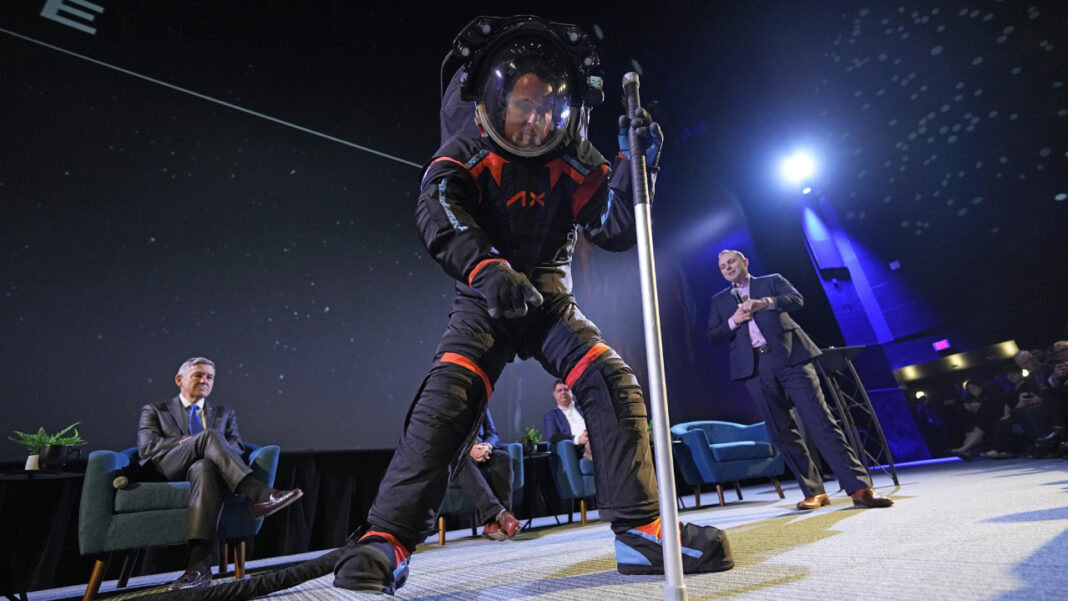After more than 50 years of quiet, the moon is about to become a destination for space travelers again. The public will soon learn the names of the four astronauts who will venture on a journey around the moon next year aboard the Artemis II rocket. The three Americans and one Canadian, to be revealed April 3 by NASA, will fly farther than any humans traveled during the Apollo missions.
The selection process remains secretive, but the astronaut pool is much more diverse than it was decades ago. As alluded to in Tom Wolfe’s 1979 book about the space race, each crew member must embody “the right stuff” – demonstrating the traits of a good teammate and effective communicator who expects the unexpected. And when the Artemis III astronauts take things a step further by landing on the moon possibly as soon as 2025, they will need something else: the right suit.
This week, NASA and Axiom Space unveiled the new spacesuit that will be worn by the first woman and the first person of color to walk on the moon. The Artemis III crew will aim to land at the unexplored lunar south pole, home to frigid, permanently shadowed regions where ice has remained frozen for billions of years. The reimagined suit allows for more range of motion and includes extra-insulated boots and other innovations that should make it easier to explore the lunar surface.
And it’s about time – the spacesuits US astronauts wear haven’t been upgraded since the Space Shuttle Program was active. The prototype of the new design Axiom Space revealed appears black, blue and orange. However, the actual suits will be the traditional white from the Apollo days to protect the astronauts from wild temperature swings.
Dinosaurs were some of the largest creatures to roam Earth. Now, researchers have discovered one that broke records among giants. A dino called Mamenchisaurus sinocanadorum once enjoyed munching on the leafy greens of trees – which it handily could reach because the creature had a massive neck longer than a school bus.
The sauropod’s 49. 5-foot-long (15. 1-meter-long) neck, the longest of any known dinosaur, allowed it to stand in place and chow down for hours.
But how did Mamenchisaurus manage not to feel weighed down by such an extreme feature? The secret was in its air-filled bones. A stunning species of orchid has been newly discovered blooming in rural gardens and suburban balcony planters in Japan. The rare find, with delicate pink-and-white blossoms that appear to be spun from glass, belongs to a group of orchids called Spiranthes, or “ladies tresses.
” Scientists were able to tell this orchid apart from others in its family because the flowers bloomed earlier and the plant has smooth, rather than hairy, stems. When a NASA mission scientist recently revisited images of Venus from 1991 captured by the Magellan spacecraft, he noticed something unusual. Two photos of the same feature taken months apart seemed drastically different.
Eight months after Magellan’s first pass, a vent on one of the planet’s largest volcanoes had nearly doubled in size and was filled with a lava lake. The change reveals never-before-seen evidence of volcanic activity on the surface of Venus, something future missions can follow up on within a decade. Meanwhile, the search for water on Mars has turned up signs of a recent glacier that existed near the red planet’s warm equator.
The glacier is no longer present. But researchers spotted a crusty layer of salt that preserved surprising details of the ice chunk – and it’s right in an area where humans may eventually land on Mars. “Beware of The Blob, it creeps / And leaps and glides and slides / Across the floor!” Those dramatic lyrics are from the theme song of the 1958 film “The Blob,” but they also serve as a warning about a giant mass making its way across the ocean.
A tangled ball of sargassum seaweed spanning more than 5,000 miles (8,047 kilometers) has formed in the Atlantic Ocean. The floating blob – which may be the largest on record – could dump smelly clumps of seaweed on beaches in Florida and elsewhere along the Gulf of Mexico this summer. The unprecedented phenomenon could pose grave risks for humans and ocean life alike.
The seaweed mass makes for a great habitat for fish and other marine creatures, but it can also create dead zones – and even release toxic gas once it hits land. Prepare to have your mind blown: – This may be scarier than the blob. Scientists found “terrifying” rocks made from plastic debris on Brazil’s volcanic Trindade Island.
– The remains of a Roman aristocrat were found buried with her jewelry in a lead-lined coffin after archaeologists discovered a hidden cemetery in northern England. – The James Webb Space Telescope captured a scintillating new image of a rare star that’s on the brink of exploding. The-CNN-Wire ™ & © 2023 Cable News Network, Inc.
, a Warner Bros. Discovery Company. All rights reserved.
.
From: abc7
URL: https://abc7news.com/spacesuit-moon-astronaut-artemis/12974450/



